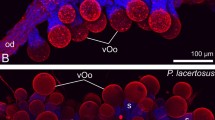Abstract
THE follicular epithelium in insects is said to secrete the chorion after the egg is fully formed. According to Snodgrass1, the follicular epithelium secretes a substance which is discharged over the fully formed egg and there hardens to form the chorion. Wigglesworth2 is also of similar opinion. The subject has also been touched upon by Biedermann3, Cappe de Baillon4 and Beament5.
This is a preview of subscription content, access via your institution
Access options
Subscribe to this journal
Receive 51 print issues and online access
$199.00 per year
only $3.90 per issue
Buy this article
- Purchase on Springer Link
- Instant access to full article PDF
Prices may be subject to local taxes which are calculated during checkout
Similar content being viewed by others
References
Snodgrass, R. E., “Principles of Insect Morphology”, 560 (McGraw-Hill, 1935).
Wigglesworth, V. B., “Principles of Insect Physiology”, 463 (Methuen, 1950).
Beidermann, W., Winterstein's Handb. d. vergl. Physiol., 3 (1), 497 (1914).
Cappe de Baillon, C.R. Acad. Sci., Paris, 196, 809 (1933).
Beament, J. W. L., Proc. Roy. Soc., B, 133, 407 (1946); J. Exp. Biol., 23, 213 (1947).
Cragg, F. W., Ind. J. Med. Res., 8, 32 (1920).
Author information
Authors and Affiliations
Rights and permissions
About this article
Cite this article
DASGUPTA, B., RAY, H. Role of the Nuclei of the Follicle Cells in the Formation of the Chorion in Cimex lectularius columbarius Jen.. Nature 175, 216–217 (1955). https://doi.org/10.1038/175216a0
Issue Date:
DOI: https://doi.org/10.1038/175216a0
This article is cited by
-
Untersuchungen am Ei-Chorion der termite Kalotermes flavicollis fabr. unter normalen bedingungen und nach behandlung des weibchens mit colcemid (Insecta, Isoptera)
Zeitschrift f�r Morphologie der Tiere (1971)
Comments
By submitting a comment you agree to abide by our Terms and Community Guidelines. If you find something abusive or that does not comply with our terms or guidelines please flag it as inappropriate.



